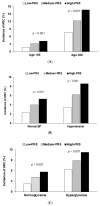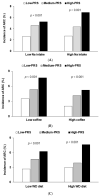Polygenetic-Risk Scores Related to Crystallin Metabolism Are Associated with Age-Related Cataract Formation and Interact with Hyperglycemia, Hypertension, Western-Style Diet, and Na Intake
- PMID: 33213085
- PMCID: PMC7698476
- DOI: 10.3390/nu12113534
Polygenetic-Risk Scores Related to Crystallin Metabolism Are Associated with Age-Related Cataract Formation and Interact with Hyperglycemia, Hypertension, Western-Style Diet, and Na Intake
Abstract
Age-related cataract (ARC) development is associated with loss of crystalline lens transparency related to interactions between genetic and environmental factors. We hypothesized that polygenetic risk scores (PRS) of the selected genetic variants among the ARC-related genes might reveal significant genetic impacts on ARC risk, and the PRS might have gene-gene and gene-lifestyle interactions. We examined the hypothesis in 1972 and 39,095 subjects aged ≥50 years with and without ARC, respectively, in a large-scale hospital-based cohort study conducted from 2004 to 2013. Single nucleotide polymorphisms (SNPs) of the genes related to ARC risk were identified, and polygenetic risk scores (PRS) were generated based on the results of a generalized multifactor dimensionality reduction analysis. Lifestyle interactions with PRS were evaluated. The PRS derived from the best model included the following six SNPs related to crystallin metabolism: ULK4_rs1417380362, CRYAB_rs2070894, ACCN1_rs55785344, SSTR2_rs879419608, PTN_rs322348, and ICA1_rs200053781. The risk of ARC in the high-PRS group was 2.47-fold higher than in the low-PRS group after adjusting for confounders. Age, blood pressure, and glycemia interacted with PRS to influence the risk of ARC: the incidence of ARC was much higher in the elderly (≥65 years) and individuals with hypertension or hyperglycemia. The impact of PRS on ARC risk was greatest in middle-aged individuals with hypertension or hyperglycemia. Na, coffee, and a Western-style diet intake also interacted with PRS to influence ARC risk. ARC risk was higher in the high-PRS group than in the low-PRS group, and high Na intake, Western-style diet, and low coffee intake elevated its risk. In conclusion, ARC risk had a positive association with PRS related to crystallin metabolism. The genetic impact was greatest among those with high Na intake or hypertension. These results can be applied to precision nutrition interventions to prevent ARC.
Keywords: Age-related cataract; coffee intake; crystalline; genetic impact; hyperglycemia; hypertension.
Conflict of interest statement
The authors declared no potential conflict of interest.
Figures



Similar articles
-
Hyperglycemia and Hypo-HDL-cholesterolemia Are Primary Risk Factors for Age-related Cataract, and a Korean-style Balanced Diet has a Negative Association, based on the Korean Genome and Epidemiology Study.J Korean Med Sci. 2021 Jun 14;36(23):e155. doi: 10.3346/jkms.2021.36.e155. J Korean Med Sci. 2021. PMID: 34128595 Free PMC article.
-
Polygenetic-Risk Scores for A Glaucoma Risk Interact with Blood Pressure, Glucose Control, and Carbohydrate Intake.Nutrients. 2020 Oct 26;12(11):3282. doi: 10.3390/nu12113282. Nutrients. 2020. PMID: 33114701 Free PMC article.
-
Regular exercise, alcohol consumption, and smoking interact with the polygenetic risk scores involved in insulin sensitivity and secretion for the risk of concurrent hyperglycemia, hypertension, and dyslipidemia.Nutrition. 2021 Nov-Dec;91-92:111422. doi: 10.1016/j.nut.2021.111422. Epub 2021 Jul 21. Nutrition. 2021. PMID: 34433106
-
Genetics of crystallins: cataract and beyond.Exp Eye Res. 2009 Feb;88(2):173-89. doi: 10.1016/j.exer.2008.10.011. Epub 2008 Nov 1. Exp Eye Res. 2009. PMID: 19007775 Review.
-
sHSP in the eye lens: crystallin mutations, cataract and proteostasis.Int J Biochem Cell Biol. 2012 Oct;44(10):1687-97. doi: 10.1016/j.biocel.2012.02.015. Epub 2012 Mar 2. Int J Biochem Cell Biol. 2012. PMID: 22405853 Review.
Cited by
-
Ultra-processed foods consumption and risk of age-related eye diseases: a prospective cohort study with UK biobank.Eur J Nutr. 2024 Dec;63(8):3175-3186. doi: 10.1007/s00394-024-03498-5. Epub 2024 Sep 20. Eur J Nutr. 2024. PMID: 39302424
-
Transcriptome Meta-Analysis Uncovers Cell-Specific Regulatory Relationships in Embryonic, Juvenile, Adult, and Aged Mouse Lens Epithelium and Fibers.Invest Ophthalmol Vis Sci. 2025 Apr 1;66(4):42. doi: 10.1167/iovs.66.4.42. Invest Ophthalmol Vis Sci. 2025. PMID: 40238114 Free PMC article.
-
Polygenic Risk Score Improves Cataract Prediction in East Asian Population.Biomedicines. 2022 Aug 8;10(8):1920. doi: 10.3390/biomedicines10081920. Biomedicines. 2022. PMID: 36009466 Free PMC article.
-
Genomics and Personalized Nutrition.Nutrients. 2021 Mar 30;13(4):1128. doi: 10.3390/nu13041128. Nutrients. 2021. PMID: 33808074 Free PMC article.
-
Associations between the Genetic Heritability of Dyslipidemia and Dietary Patterns in Korean Adults Based on Sex Differences.Nutrients. 2023 Oct 16;15(20):4385. doi: 10.3390/nu15204385. Nutrients. 2023. PMID: 37892463 Free PMC article.
References
-
- Kang J.H., Wu J., Cho E., Ogata S., Jacques P., Taylor A., Chiu C.-J., Wiggs J.L., Seddon J.M., Hankinson S.E., et al. Contribution of the Nurses’ Health Study to the Epidemiology of Cataract, Age-Related Macular Degeneration, and Glaucoma. Am. J. Public Health. 2016;106:1684–1689. doi: 10.2105/AJPH.2016.303317. - DOI - PMC - PubMed
MeSH terms
Substances
Grants and funding
LinkOut - more resources
Full Text Sources
Medical
Research Materials

